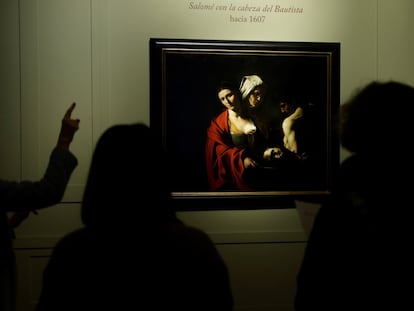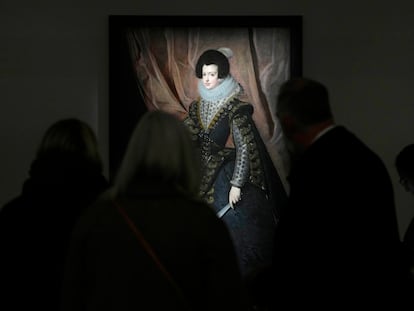The artist who wanted to do it all and became a publisher
An exhibition at the Reina Sofia Museum in Spain shows the path of Something Else Press, the atypical publishing house founded by creator and writer Dick Higgins in 1963

This is not exactly an exhibition of artists’ books. It is not the deep dive into the archives that we are accustomed to seeing at the Reina Sofia Museum. It is not just the work of a creator, not an anthology, and not just the story of an exciting failure. Rather, it is something else.
In the early 1960s, Dick Higgins — a composer, visual artist and writer — was unable to publish his book Jefferson’s Birthday/Postface under the label that his friend George Maciunas had established for the Fluxus group’s writings. His pride wounded, Higgins decided to set up his own self-publishing house, although he couldn’t decide on the name of his project — Fluxus Papers, Shirtsleeves Press — until fellow artist Alison Knowles told him: “Call it something else.” With that, Something Else Press was born in late 1963. The back cover of Higgins’ first book printed the publishing house’s founding manifesto, based precisely on naming and printing that which did not end up being something, that which did not fit into the objectual vision of art or a classical idea in the world of book publishing. Higgins’s second publication was a box full of postcards by Robert Filliou called Ample Food for Stupid Thought. Each compiled an absurd and essential question containing somber humor and political resonances: “Why is this the land of the free and the homeland of the brave?” “Don’t you think you’re imposing your personal taste?” “When will this nonsense end?” That publication was followed by the complete works of Gertrude Stein, radical texts by Fluxus artists like Al Hansen, anthologies of concrete poetry, scores by John Cage and Higgins himself... But the publishing house also printed treatises on mycology and home gardens, monthly newsletters, and manifestos.

In its unstable 11-year existence, the publishing house maintained the premise of being something else and as such printed 50 or so works that still do not fit into the parameters of a publishing catalog today. Because of the relatively high price of books, Higgins created the collection Great Bear Pamphlets, composed of photocopiable pamphlets that could be found, as he himself proudly announced, “next to the vegetable bin in the supermarket.” In one of those pamphlets, Higgins developed a term, intermediality, which is crucial to understanding Something Else Press’s conceit as a whole. Coleridge had already used the word, and the editor-artist rescued it to situate those practices that fell between different forms and areas. Intermedia would be that which is on the edge of things, which not only combines modes of production or ways of appearing (it is not just art, it is not just publishing, nor is it just a score, nor just a happening...), but which seeks to occupy the space of its limits and work with them.
Higgins understood that the best way to make his art was in that crack between the artistic avant-garde and the capitalist system.
The exhibition’s curators, Alice Centamore and Christian Xatrec, have brilliantly resolved this issue of always wanting to be something else, one that is complicated in ways that few others are and one that is extremely difficult to exhibit. Through well-measured cartouches and succinct and clear explanations, they speak of the publishing house as Higgins’s total work and relate it to the arts’ linguistic turn in the 1960s, as proposed by Liz Kotz in Words to be Looked At. In the catalog, the curators ask the key question: “When conceiving of an exhibition about a publishing house that is the work of an artist, but is not, stricto sensu, a work of art, one might ask: what is the object?” They find the object, or the non-object, or that other thing, or whatever Higgins prefers to call it, in the form of publishing production itself. The artist was discovering that very thing during the publishing process, in which he understood that it was precisely by occupying that minuscule crack between the artistic avant-garde and the capitalist production system that he could best carry out his art. On occasions when that crack became too narrow, Higgins resorted to using a pseudonym, Camille Gordon, to sign his texts in the publisher’s bulletins. In them, he set forth theories, experiments and chronicles of the artistic activity of the moment, playing with the expectations of a format that seemed traditional but was being turned against itself.

Higgins’s life, friendships and artistic needs and those of the publishing house merged such that when he wanted to leave the project and appoint a new editor-in-chief, the company was beset by debt. Higgins was well aware that he was not going to be able to waywardly register with the establishment for long: either he would allow himself to be eaten up by the publishing industry and run his publishing house as a business, or he would take his experiment all the way and go down with it. Of course, he opted for the latter and Something Else Press closed for good in 1974. In the final years of the press, they traded its Fifth Avenue offices — an ironic emulation of the big publishing companies — for a family farm in Vermont and opened and closed Something Else Gallery, where Alison Knowles exhibited her eight-foot-tall Big Book.
This exhibition at the Reina Sofia influences how we understand art despite its apparent discretion and shows that it is possible to expose complex or unremarkable issues seductively and accessibly. The activities parallel to the exhibition, which are usually crucial in this museum (as in the Unstable Office of Free Translation and the performative visit organized by Maria Salgado and Tatiana Arias in September), strikingly complement the publishing house’s purpose and deepen its experimentation free of academicism and without neglecting the spirit in which Higgins formulated his art. It seems that there was indeed something else.
Call it something else. Something Else Press, Inc (1963–1974). Reina Sofia Museum. Madrid. Open until January 22, 2024.
Sign up for our weekly newsletter to get more English-language news coverage from EL PAÍS USA Edition
Tu suscripción se está usando en otro dispositivo
¿Quieres añadir otro usuario a tu suscripción?
Si continúas leyendo en este dispositivo, no se podrá leer en el otro.
FlechaTu suscripción se está usando en otro dispositivo y solo puedes acceder a EL PAÍS desde un dispositivo a la vez.
Si quieres compartir tu cuenta, cambia tu suscripción a la modalidad Premium, así podrás añadir otro usuario. Cada uno accederá con su propia cuenta de email, lo que os permitirá personalizar vuestra experiencia en EL PAÍS.
¿Tienes una suscripción de empresa? Accede aquí para contratar más cuentas.
En el caso de no saber quién está usando tu cuenta, te recomendamos cambiar tu contraseña aquí.
Si decides continuar compartiendo tu cuenta, este mensaje se mostrará en tu dispositivo y en el de la otra persona que está usando tu cuenta de forma indefinida, afectando a tu experiencia de lectura. Puedes consultar aquí los términos y condiciones de la suscripción digital.
More information
Archived In
Últimas noticias
Welcome to the post-religion era: The idea of Christianity as the absolute truth has become obsolete
‘I thought you would like it’: The risky sexual practice popularized by TV shows and TikTok
The digitalization of tourism: ‘They promise experiences and gave us the worst possible one’
Mexican peso defies uncertainty with forecasts of a new period of stability in 2026
Most viewed
- Sinaloa Cartel war is taking its toll on Los Chapitos
- Reinhard Genzel, Nobel laureate in physics: ‘One-minute videos will never give you the truth’
- Oona Chaplin: ‘I told James Cameron that I was living in a treehouse and starting a permaculture project with a friend’
- Why the price of coffee has skyrocketed: from Brazilian plantations to specialty coffee houses
- Silver prices are going crazy: This is what’s fueling the rally










































